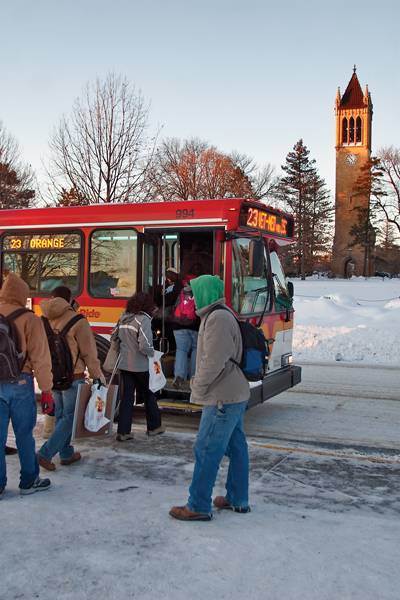Worrisome weather: Wind chill warning in effect

CyRide was a popular choice on Wednesday for students trying to stay warm, traveling in the negative double-digit temperatures. Photo: Benjamin Brabant/Iowa State Daily
January 14, 2009
While the winter winds howl and temperatures plummet to intolerable levels, ISU students will still make their ways to classes.
With Thursday’s high expected to be six below zero, the National Weather Service issued a wind chill warning for Story County, which expires at noon Thursday.
Warren Madden, vice president for business and finance, said if conditions are difficult enough that students can’t walk or drive, and the wind chill is 40 or 50 degrees below zero, the university will consider closing. However, he said, since more than 80 percent of students live on campus or within CyRide limits, it is unlikely the university will close.
Because winds are expected to die down Thursday morning, William Gallus, professor of geological and atmospheric sciences, said he thinks conditions will be safe enough for classes to be held.
Madden said wind chill factor was 50 degrees below zero on one occasion in 2003, causing school to be canceled.
Gallus said daytime temperatures fell to 14 below zero with wind chill close to 50 below in 1996, also causing classes to be canceled that day.
Recent snowfall in Ames, Gallus said, is contributing to bitter temperatures.
“Snow helps to radiate away a lot of heat, so typically the very coldest weather we get in Iowa happens when you have a lot of nice white, fluffy snow on the ground,” he said. “I think we’ve had 15 inches in the last 5 days here in Ames, so it seems like we have the perfect set up for extreme cold tonight.”
Gallus said Alaska recently experienced a cold wave with temperatures dropping to 65 below zero and also set records for how long the temperature stayed below zero. The cold air from Alaska, he said, is making its way down to Iowa.
“Right now we have a big ridge on the west coast, so the air is rising from Hawaii clear up to Alaska and then the air flow is coming the whole way down, straight from the north into Iowa,” he said. “So it’s steering a big pool of cold air out of Canada, down into the Midwest,”
During the winter months, parts of Alaska receive little or no sunlight to heat up the surrounding air. Usually, Gallus said, cold air from the north stays around the polar regions.
“We kind of have an unusual situation now where the jet stream is taking that cold air and is plowing it straight into Iowa,” he said.
For those from warmer climates, Thursday’s temperatures could come as a shock.
“It’s pretty freezing compared to where I’m from in South China. I was telling my friends that if I were a little bit lighter I would be blown away like a kite,” said Cici Vang, freshman in finance. “It’s my first year here. Hopefully I will survive. I didn’t know it would be so cold here. It’s not the North Pole or the South Pole so it shouldn’t be so cold. I think my physiology is changing though, and now when I go home I will probably be hot.”
Although Thursday may set record lows, Gallus said warmer air will be headed toward the Midwest in the next couple of days and we may see temperatures rise above freezing over the weekend.
Shelter still open
For those seeking shelter from the cold, space in a temporary housing shelter, the Emergency Residence Project, 225 S. Kellogg Ave., is still available.
Vic Moss, director of the shelter, said there are still beds available for single men, but space for women and families is full.
Moss said during harsh winter conditions the shelter will not turn people away. Because two families cannot be housed in one room, if the shelter runs out of space for families, Moss said the shelter may temporarily put families in affordable hotel rooms.
“Our family area is virtually always full,” Moss said. “Our business is pretty steady throughout the year, we really don’t fluctuate.”
He said the shelter really has no option to turn people away during winter because other shelters are as far away as Des Moines, which he said would probably have more problems with space than the Ames shelter.
“It’s also a life-threatening situation,” he said.
Frostbite risk
According to the Center for Disease Control, frostbite causes injury to the nose, fingers, toes, ears, chin and cheeks due to freezing. Exposed skin in extremely cold weather is the most common cause of frostbite. Signs of frostbite include a numb feeling, white- or gray-colored skin and waxy- or firm-feeling skin on the affected area. The CDC advises those who believe they have frostbite to seek medical attention, especially if the victim is at risk for hypothermia.
At wind chill temperatures of 19 degrees below zero, uncovered skin can freeze after 30 minutes of exposure, according to the National Weather Service Web site.
Past temperatures
Jan. 15, 2009
Projected high: -4 degrees
Projected low: -10 degrees
Jan. 15, 2008
High: 37 degrees
Low: 10 degrees
Jan. 15, 2007
High: 19 degrees
Low: 0 degrees
Jan. 15, 2006
High: 55 degrees
Low: 30 degrees
Jan. 15, 2005
High: 5 degrees
Low: -8 degrees
Jan. 15, 2004
High: 37 degrees
Low: 10 degrees
Jan. 15, 2003
High: 21 degrees
Low: 1 degrees
Jan. 15, 2002
High: 28 degrees
Low: 21 degrees
Jan. 15, 2001
High: 33 degrees
Low: 21 degrees
Jan. 15, 2000
High: 51 degrees
Low: 23 degrees






